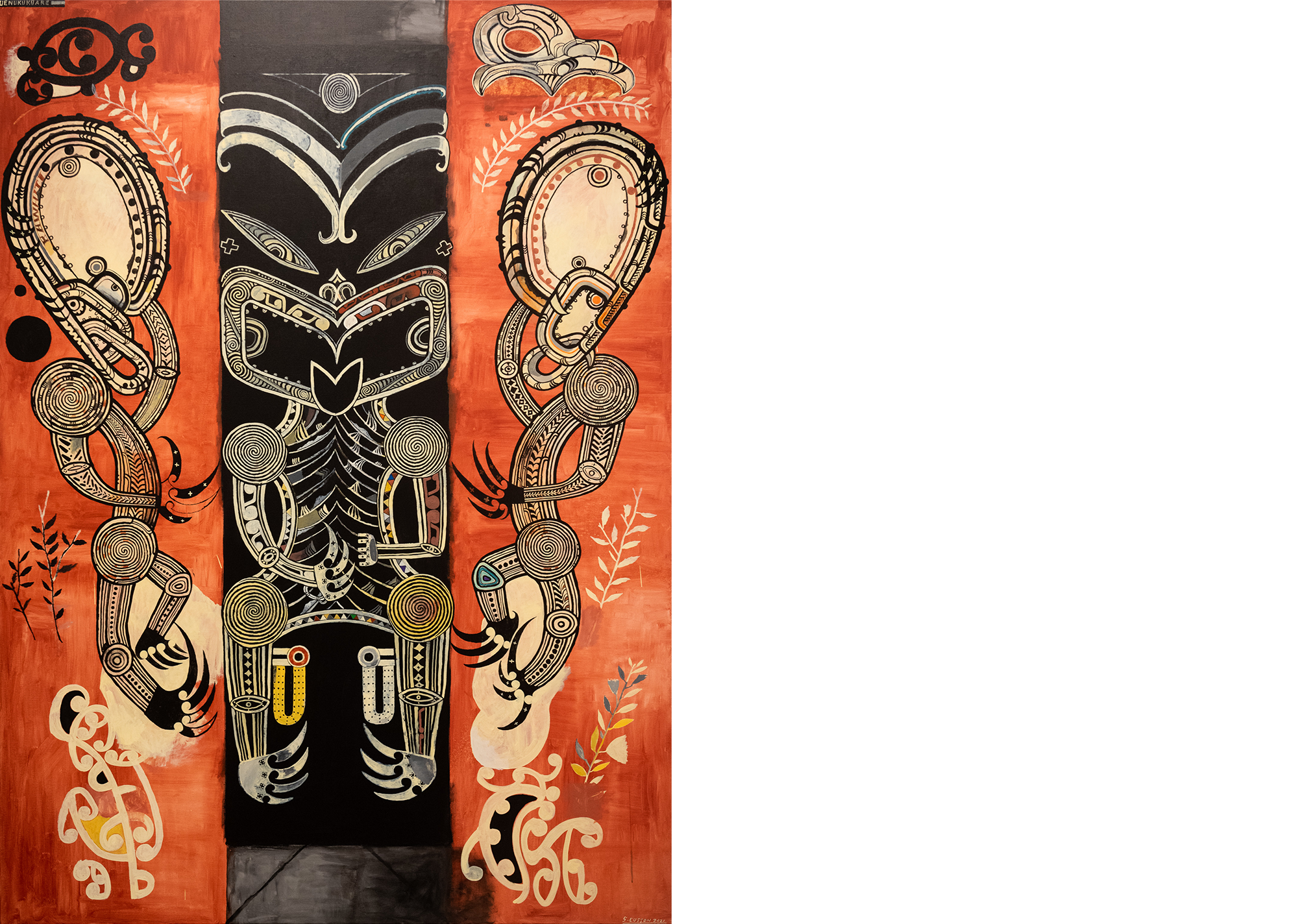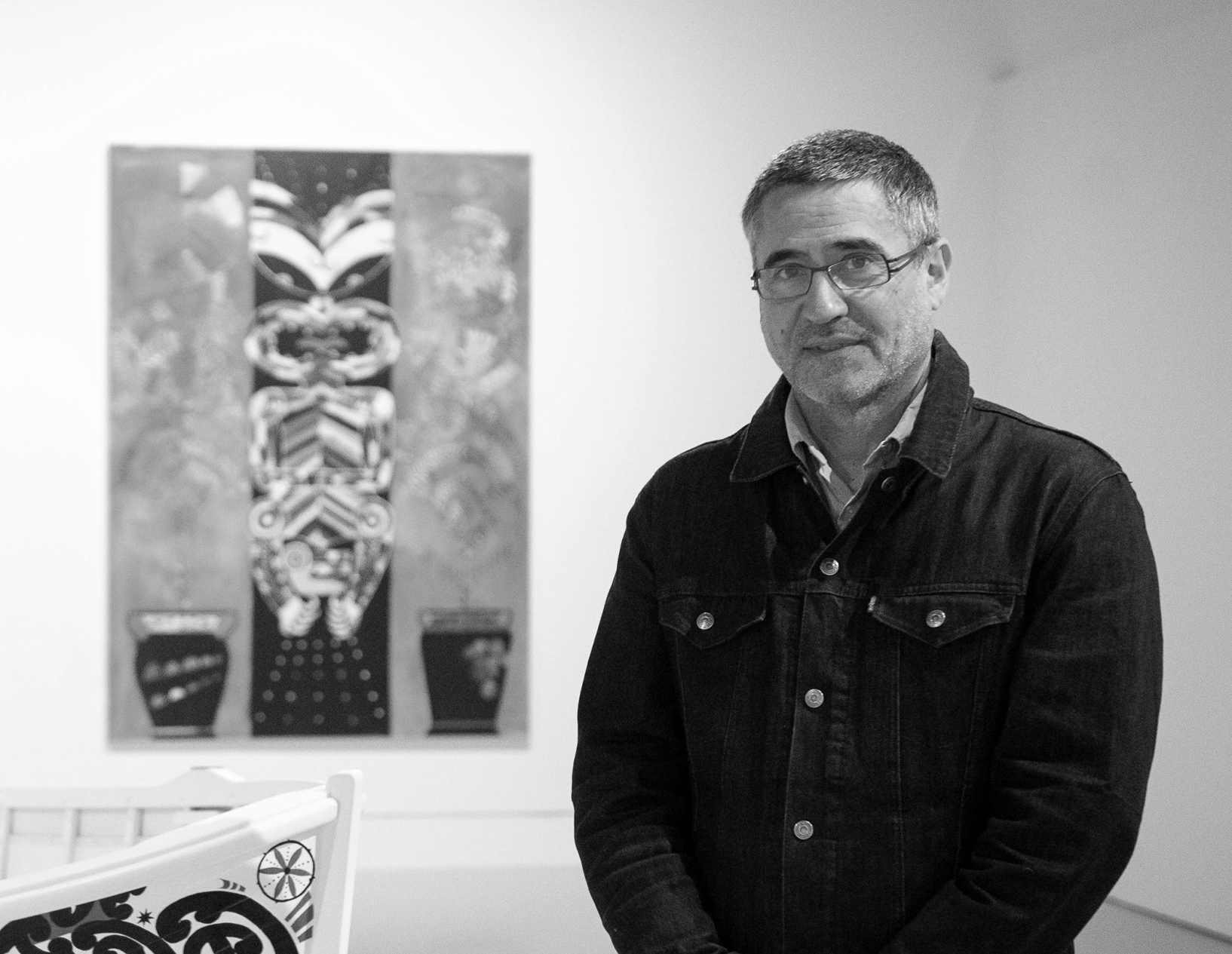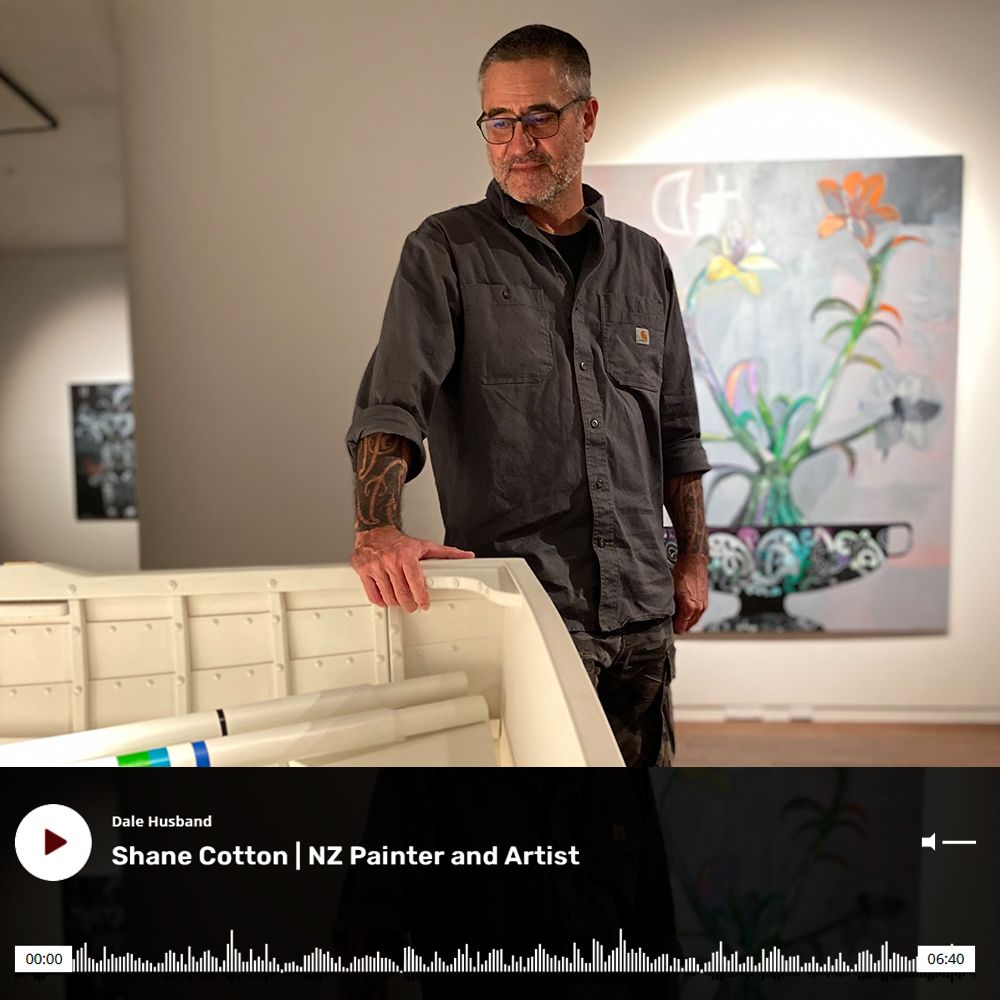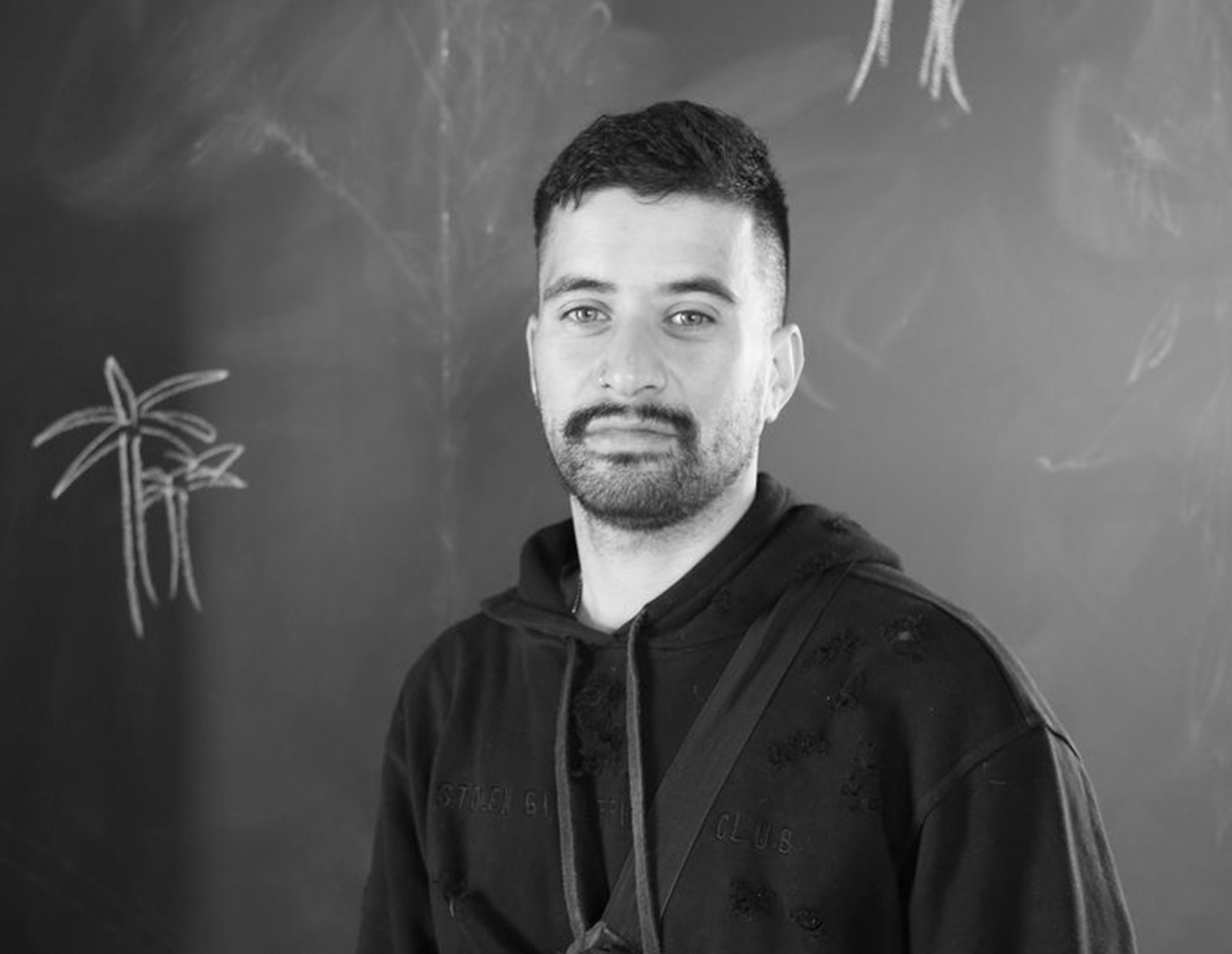Shane Cotton: Kei Muri Ngā Mea I Te Rā

Courtesy of the artist and Gow Langsford Gallery.
Shane Cotton: Kei Muri Nga Mea I Te Rā
Comprised of new and recent works this exhibition presents painting, screen prints and sculptural forms and is grounded in the exploration of possibility of meaning, and the unending search to know and understand more about who we are and where we are from.
Kei Muri Ngā Mea I Te Ra is Kororāreka (Russell) based artist Shane Cotton’s (Ngāti Rangi, Ngāti Hine, Te Uri Taniwha) first solo exhibition in Te Tai Tokerau (Northland).
The exhibition references Ngāpuhi tūpuna, important landmarks within Te Tai Tokerau and includes a visual language featuring vase forms, te taiao (the natural world), maunga, tiki, kōwhaiwhai and waka.
It includes Uenuku Kuare, a tūpuna depicted in tiki form and supported by two manaia framing this important figure. A suite of six new screenprints expand on the vessel motif, while the sculptural work Te Puāwai, that has been included in recent major exhibitions Toi Tu Toi Ora at Auckland Art Gallery and Te Puāwai at The Dowse Art Museum, features Cotton’s iconography painted directly onto the body of a hand-crafted boat. While two new works make a debut in this exhibition. Te Puāwai II and No Ordinary Bird feature a floral element. This lily-like plant grows out of one of Cotton’s vessel forms in one painting and is held delicately by the tiki in the other painting.
Each work tells its own story in Kei Muri Nga Mea I Te Rā and is an example of Cotton’s unique understanding of paint and composition developed over 30 years of painting.
Taupoki katoa i ngā mahi hou ōnaianei, ko tēnei whakatūranga ka tohatoha waituhi, mātātuhi perēhitanga me ngā āhua tāraitanga, ā, ka whakamōhiotia ki roto i te totorotanga o te haurapa o te tikanga, ā, te totoro haere noa kia mōhio, kia mārama ina noa atu, ko wai tātou, ā, nō hea tātou.
Kei Muri Ngā Mea I Te Ra ko Kororāreka) te kāinga nohoanga a te ringa toi a Shane Cotton (Ngāti Rangi, Ngāti Hine, Te Uri Taniwha) nānā tēnei whakaatūranga tōtahi tuatahi ki Te Tai Tokerau.
Ka whakatohutohu te whakaatūranga nei i ngā tūpuna a Ngāpuhi, ngā tūnga whenua whakahirahira ki roto i Te Tai Tokerau, ā, ka hui katoa i tētahi reo ataata ka whakatohu āhua ipu, te tai ao, maunga, tiki, kōwhaiwhai me te waka.
Ka hui katoa a Uenuku Kuare, he tūpuna ka whakaahuatia ki te āhua tiki, ā, tautokotia e ngā manaia e rua e tāparepare ana i tēnei whakatupu whakahirahira. He hātepe e ono o ngā mātātuhi perēhitanga ka whakawhānuitia ki runga i te waitohu ipu. I te wā ka kua hui katoatia te mahi tāraitanga a Te Puāwai ki roto i ngā whakaatūranga mātua ōnaianei i a Toi Tū Toi Ora ki Te Huarewa Toi o Tāmaki Mākaurau me Te Puāwai ki Te Whare Taonga Toi Dowse, ka whakaatū i ngā waituhi mātātuhi a Cotton ki runga tonu i te tinana o tētahi poti hangaia ā ringa. Kei ngā mahi hou e rua ka whakaatūria tuatahitia ki tēnei whakaatūranga. Ko Te Puāwai II me No Ordinary Bird ka whakaatū i tētahi huanga putiputi. Ko tēnei hua riterite ki te rengarenga ka tupu ake i tētahi o ngā āhua waka ki tētahi waituhi me te āta mau pupuri e te tiki ki tērā atu waituhi.
Ko ia mahi ka whāki i tōna ake kōrero ki Kei Muri Nga Mea I Te Rā, ā, he tauira tūturu nā Cotton mō te māramatanga o te waituhi me te waihanga kua whakatupuria puta noa i ngā tau 30 o te waituhinga.
Artist
Shane Cotton (Ngāpuhi, Ngāti Rangi, Ngāti Hine, Te Uri Taniwha)
Cotton is one of New Zealand’s most celebrated artists. He completed a Bachelor of Fine Arts at the University of Canterbury’s Ilam School of Fine Arts in 1988 and in 1993, Cotton joined Robert Jahnke as a lecturer to the Toioho ki Āpiti Bachelor of Māori Visual Arts programme, Massey University, Palmerston North. That same year his paintings moved from exploring biomorphic forms and abstracted concepts to a focused examination of New Zealand’s Māori and Pākehā cultural histories, often referencing painted meeting houses created under the Māori prophet Te Kooti Arikirangi Te Tūruki.
His art practice has been the subject of significant exhibition and publications and his paintings have led exhibition projects extensively here in Aotearoa but also throughout Australia, The United States and across Europe. Key exhibitions include: Kohia Ko Taikaka Anake, National Art Gallery, Wellington (1991); Shane Cotton Survey 1993–2003, City Gallery Wellington Te Whare Toi (2003) and Auckland Art Gallery Toi o Tāmaki (2004); Paradise Now? Contemporary Art from the Pacific, Asia Society Museum, New York (2004); The Hanging Sky, Institute of Modern Art, Brisbane, touring to City Gallery Wellington, Christchurch Art Gallery Te Puna o Waiwhetū and Campbelltown Arts Centre, Sydney (2012–13). His work was also featured in Toi Tu Toi Ora: Contemporary Māori Art, Auckland Art Gallery in 2020. In 1988, Cotton was the Frances Hodgkins Fellow at the University of Otago, Dunedin and received the Seppelt Contemporary Art Award from Sydney Museum of Contemporary Art that same year. In 1999, he was awarded a Te Tohu Mahi Hou a Te Waka Toi/Te Waka Toi Award for New Work; and he became an Arts Foundation of New Zealand Laureate in 2008. Cotton represented New Zealand at the 2005 Prague Biennale and his work was included in the 17th Biennale of Sydney 2010. He was appointed an Officer of the New Zealand Order of Merit, for services to the visual arts, in the 2012. Shane Cotton lives and works in Russell, Northland.



Karl Chitham is Director of the Dowse Art Museum and Head of Arts & Culture at Hutt City Council. He formerly held roles as the Director and Curator of Tauranga Art Gallery and Senior Curator at Rotorua Museum. He has extensive experience as a curator having worked with many leading Aotearoa and international artists. He has written for numerous projects and was co-author/editor of Crafting Aotearoa: A Cultural History of Making in New Zealand and the Wider Moana Oceania (2020), an Ockham NZ Book Awards finalist.

James Tapsell-Kururangi is a curator, artist and writer currently working as an assistant curator at Te Tuhi. His curatorial practice centres on local Māori histories and focuses on building relationships within the community of artists he works with. His artistic practice is built from his whakapapa, in which he composes waiata that he frames within moving image artworks.